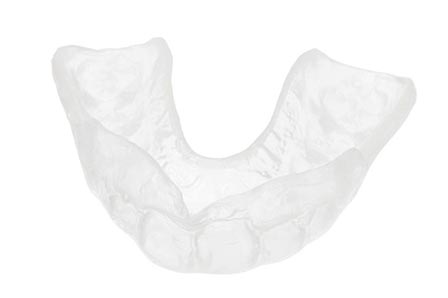TMJ/TMD Therapy

Bruxism, commonly known as tooth grinding, is the clenching together of the upper
and lower jaw, accompanied by the grinding of the teeth. This behavior removes portions
of healthy enamel from the chewing surfaces of your teeth and may cause facial pain.
Many people unintentionally clench or grind too hard at inappropriate times, such
as during sleep.
During sleep, the biting force can be up to six times greater than the pressure
during waking hours. Bruxing is like clenching your fists and holding them tightly
against each other for many hours. This behavior would cause you to end up with
sore hands, arms and shoulders. The same thing happens to your jaw muscles.
Bruxism is a force that is far more destructive to teeth than caries. Since the
enamel is worn down so much, the inside of the tooth called the dentin is exposed
causing tooth sensitivity.
Symptoms of bruxism, grinding or clenching:
- Pain or discomfort around the ears when yawning or chewing
- Tenderness of the jaw muscles
- Clicking, locking or popping of the jaw
- Jaw muscle contraction, spasms or cramping
- Loud clenching or teeth grinding
- Headaches and neck aches
- Ringing in the ears
- Tooth indentations on the tongue
- Fractures of teeth and fillings
- Teeth sensitive to cold, pressure and other stimuli
Complications:
- Damage to teeth
- May awaken sleep partner
- Worsening of TMJ dysfunction and dental disorders
- Limitation or difficulty in jaw movement
- The tips of the teeth wear flat
- Tooth sensitivity and mobility
Causes:
- Emotional stress
- Teeth that are not aligned properly or malocclusion
- Jaw, head or neck injury
- Missing teeth
Occlusal Guard Therapy:

A splint or occlusal guard, minimizes the damage to your teeth caused by bruxism or any parafunctional behavior.
An occlusal guard
is a thin transparent horseshoe-shaped retainer-like appliance made of hard or soft acrylic. This splint is worn between the teeth not allowing them to interlock. It absorbs the force of clenching and grinding and reduces joint irritation and inflammation.
It takes two simple appointments. Initially, accurate impressions of your teeth are made. A bite record is also taken. At the second appointment, the
occlusal guard
will be fitted and adjusted. It can protect you from the symptoms of teeth grinding if worn regularly. It can even lead to a better night’s sleep for you and your partner!
In addition, learning to control bad habits, such as chewing on ice, fingernails or pens will help control your symptoms. Chewing gum increases the wear and tear on the joint, giving little opportunity for your jaw to recover between meals. If you chew habitually on one side of your mouth, you concentrate all the pressure on one side. You need to learn to chew evenly to distribute the forces on both sides of your mouth.
An occlusal guard
will help your chewing muscles learn this new behavior. Relaxation or stress management techniques are also important to learn.
Back to Procedures